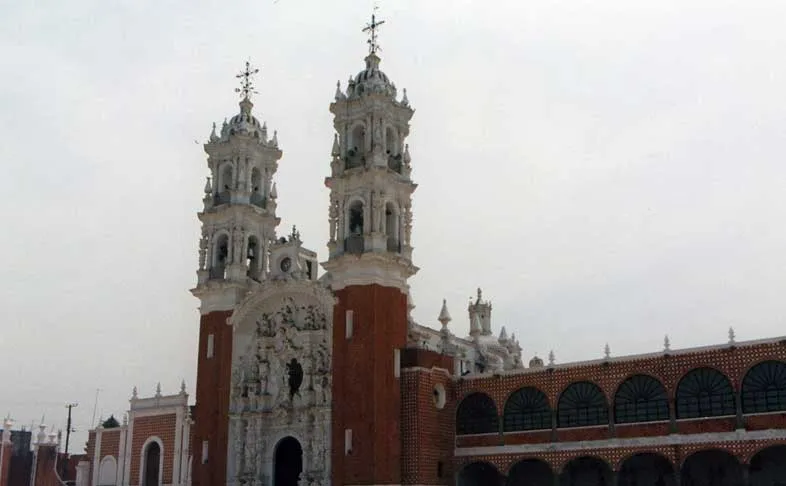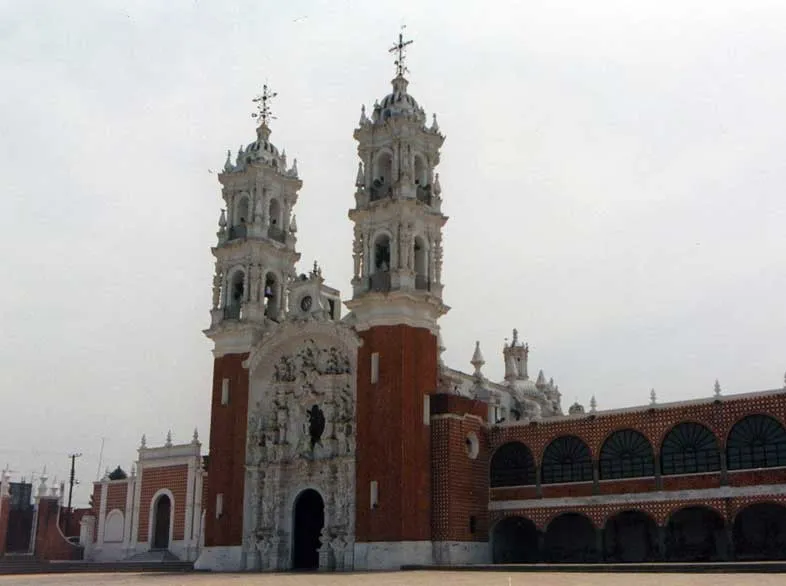
Introduction
The Sanctuary and Basilica of Ocotlán is a religious architectural complex in Mexico located in the town of Ocotlán, in the municipality of Tlaxcala, located on a hill just one kilometer from the City of Tlaxcala, capital of the homonymous state of Tlaxcala.
Due to the fact that the town of Ocotlán was an abundant place of leafy ocotes, its name is made up of two words in Nahuatl: ocotl, ‘Ocote’ and Tlatla, ‘burn’, from which Ocotlán results and which means “The Ocote that It burns”. The subject has powerfully called the attention of Ocotlan painters such as: Juan de Villalobos, Manuel Caro, Dávila Tagle, and the muralist Desiderio Hernández Xochitiotzin who have represented it as a Theophany of the Virgin Mary to the Tlaxcalan people.
History of Basilica of Our Lady of Ocotlan, Tlaxcala

The earliest mention of the shrine is found in the writing of the Tlaxcalan historian Diego Muñoz Camargo, who makes reference to there being a Franciscan missionary centre in Tlaxcala in 1588 or 1589 called Santa María Ocotla. In an earlier book he refers to a nacimiento desta agua (“source of this water”) where there is a cross in a group of forest trees that evokes great devotion.
Juan de Palafox y Mendoza, then Archbishop of Puebla, made a visit to the shrine in 1644, although he does not mention a statue. He wrote in his own account of the visit that he recited the rosary there and praised the religious devotion of the inhabitants of the town. The first mention of the statue occurs in 1689, in the frontispiece of a history of the city of Tlaxcala, published by Don Juan Benaventura Zapata y Mendoza.
Diego de Osoria de Escobar, Archbishop of Puebla in 1670, appointed Juan de Escobar as caretaker of the shrine. Juan de Escobar is responsible for constructing the shrine with its present floor plan, with the chancel, transept, and cupola. The second caretaker, Francisco Fernández, was in charge of the shrine from 1691-1716. He installed the retablo dedicated to the Virgin of Guadalupe.
The third caretaker, Manuel Loayzaga, was the man responsible for giving the shrine the appearance it has today. He put in the magnificent central retablo with the great silver niche in which the statue stands as well as the pulpit. The pièce de resistance however is the camarín, the eight-sided chapel behind the niche that is used as the Virgin’s dressing room. It is decorated with “solomonic columns”, paintings from the Life of the Virgin, portraits of Doctors of the Church who defended the Virgin Mary, and at the centre, the great round table on which the statue stands as it is being dressed.
Just as importantly, Loayzaga put the final, “official” version of the Ocotlán legend into print, publishing two editions of his book Historia de la milagrosíssima imagen de Nuestra Señora de Occotlán (sic) in 1747 and 1750.

Testimonials about the Apparition
Encounter in the woods with the Virgin Mary (Folk story)
According to tradition, the inhabitants of the town of Ocotlán tell that in the spring of 1541 a young indigenous man whom they named Juan Diego was climbing the western slope of the San Lorenzo hill and entered the forest of ocotes that at that time It existed next to a ravine. There a woman came out to meet him who greeted him and asked where are you going? It is said that the young indigenous man replied that he was going to fetch water for his patients from the plague that at that time invaded the Tlaxcalan indigenous people, damaging them to death. According to the same tradition, that mysterious woman was the Virgin Mary; herself who took him to meet healing waters in a ravine on the slope of the hill next to a ravine.
It is said that the Franciscans went to the place where they found a corpulent ocote burning without being consumed where later they opened it with an ax to discover the image of the Virgin Mary. This one of hers was taken to the chapel and placed in the place of the holder, it is said that the sacristan lowered her three times and that “her angels returned her three times to the place”.
The Statue of the Virgin Mary
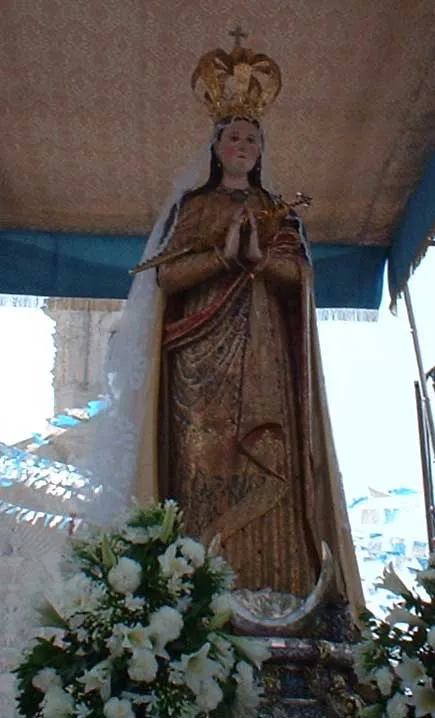
The statue of the Virgin of Ocotlán is the centrepiece of the shrine. It stands 148 cm tall and is reportedly made of pine, although this is not certain. It is carved as wearing a long tunic and mantle. The tunic is gold, with red trim. The mantle was blue at one time, but the paint has faded, revealing more gold beneath it. The statue stands erect, looking straight ahead, hands folded in front of the chest. The carved hair is brown and a replica of the image in the Museo de la Memoria shows it to have seven plaits of hair in back.
Normally, the statue is dressed in a cape. of which it owns many, and a large crown that was given to the statue in 1975. It also has pierced ears, earrings, and many finger rings in addition to the scepter it carries. A silver crescent moon with a “man in the moon” face looking up at her has been put at the base of the image to confirm its identity as an Immaculate Conception.
Devotion to the Virgin of Ocotlán is concentrated around the various processions that take place several times during the year. The statue leaves its niche over the altar on three fixed dates: New Year’s Day and the first and third Mondays in May. The Monday processions are referred to as the bajada (descent) and the subida (ascent) respectively.
The shrine of the Virgin of Ocotlán is now a parish church. It is located on a hill overlooking the city. From the zocalo go two blocks north on Independenia to Guridi y Alcocer. Turn right and when the road forks, take the left fork uphill to the church.
Virgin of Ocotlán (Our Lady of Ocotlán)
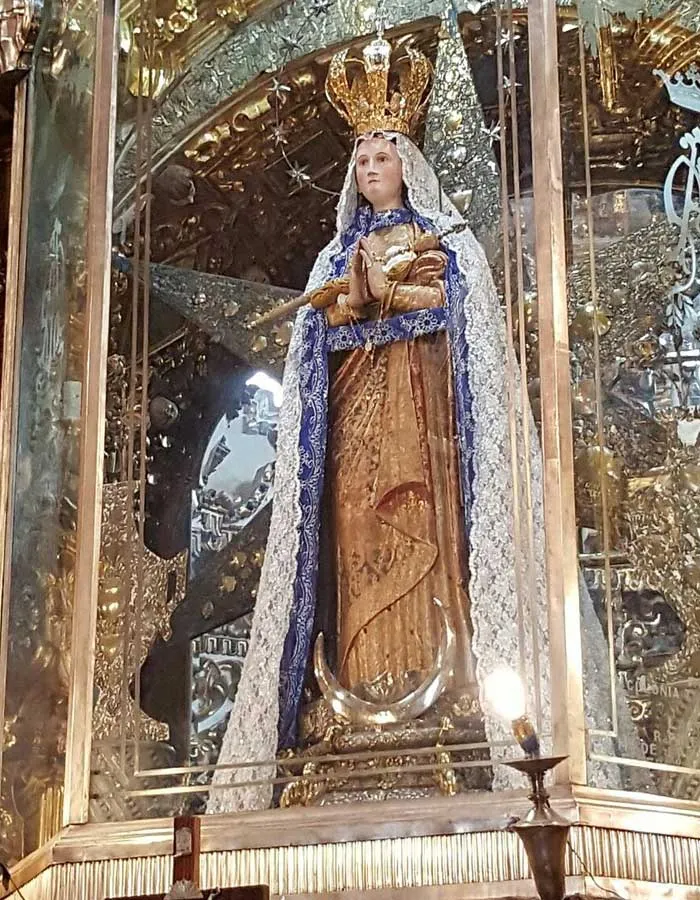
The Virgin of Ocotlán is a statue of the Blessed Virgin Mary in Ocotlán, Tlaxcala, Mexico. The Virgin of Ocotlán is the patron saint of Tlaxcala and the neighbouring state of Puebla. She was granted a decree of canonical coronation by Pope Pius X on 18 January 1909 and was crowned via Archbishop Eulogio Gillow y Zavalza on 31 July 1909.
In late spring of 1541, a young native Tlaxcalan man named Juan Diego (sometimes given as Juan Diego Bernardino) was going to draw water from a river believed at the time to have healing properties. Juan Diego was a convert to Catholicism who was known for his piety and was a topil (altar server) at the Franciscan monastery. There was an epidemic in the region and he wanted to bring the water home to his family, who were sick.
As he came to a hilltop, he encountered a beautiful lady who asked him, “God bless you, my son, where are you going?” Juan Diego explained that he was going to bring medicinal water to the sick. The lady responded, “Follow me closely. I will give you another water with which you will extinguish the contagion and cure not only your family but all who drink of it, for my heart is always inclined toward the lowly and will not suffer to see such things without remedying them.”
The woman led Juan Diego down the steep hill as night began to fall. At the bottom was a pine grove with a spring of water, that still exists today. The lady told Juan Diego that whoever drank the smallest drop would be restored to perfect health. She then told him that he would find an image of her in the pine grove where they were standing, a “true portrait of her perfections and clemencies, and that he should advise the Franciscan fathers to place it in the church of St. Lawrence” that stood on top of the hill.
Juan Diego took water from the spring and hastened off to cure the sick. Later he went to the Franciscan monastery to tell the friars of his experience. The friars observed the expression on Juan Diego’s face as he told the story and believed him, possibly also because he was a regular altar server there.
That evening they followed him back to the pine grove. In the light of the sunset, the trees seemed to burn without being consumed. One tree was particularly fat, so they opened it up with a hatchet and found the statue of Mary as Juan Diego had said they would. They prepared a litter from tree branches and flowers and lifted the statue up onto their shoulders to carry it to the church of St. Lawrence.
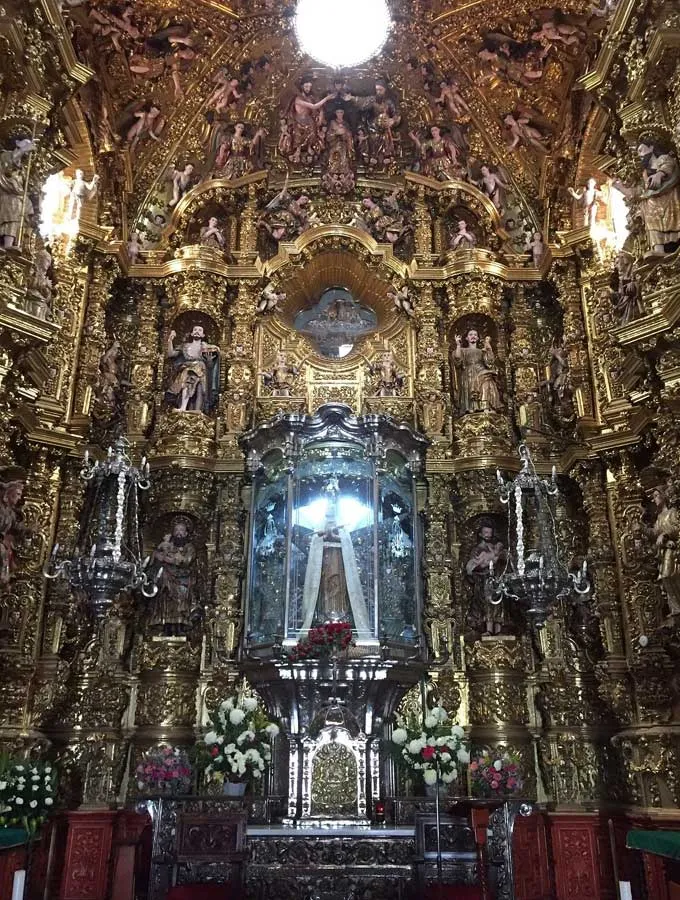
Hojacastro's Relationship
The anthropologist Hugo G. Nutini, assures that he discovered in 1963 a 16th century document entitled Relation of the apparition of the Virgin of Ocotlán, by Fray Martín Sarmiento de Hojacastro, according to the Bishop of Tlaxcala.
It is signed by Hojacastro in the city of Tlaxcallan “in the month of April one thousand five hundred and forty-seven years.” It says: Taken and received the Guardian’s oath, he promised to tell the truth about the Indian Juan Diego and being questioned he said he had spoken with the Holy Virgin Mary twelve days before last May, inside a burning pine tree, dressed in a white huipil and a blue titixtle, which he commissioned to build the temple in his honor.
The Chronological History of Buenaventura Zapata
Buenaventura Zapata, a Tlaxcalan writer who in the 17th century. He was governor of Tlaxcala during the years 1651-1674 and wrote in Nahuatl, “The chronological history of the city of Tlaxcala” where he affirms in the prologue, that there is a writing about the appearance of the virgin in the hands of a cacique and puts the doubt that it is not authentic, even though it refers to a remote and obscure tradition and the substance of it is that the primitive, when the hill was still full of pine trees, from which it was named, a natural of its contours and he saw a burning pine tree and that this vision was repeated so many times that it motivated him to give an account to his spiritual parents, who were then members of the seraphic family.
That with burning zeal they went to the place and ordered the pine to be cut down, they found your image drawn and formed inside. Francisco de la Maza affirms that according to the unpublished Annals of Tlaxcala, the apparition of the Virgin occurred in 1641.

Juan Diego
He was originally from the town of Santa Isabel Xiloxoxtla (Flor de corn). Father Florencia refers to him as a good Indian who served the religious and visited the sick with the plague.
Fray Martín de Hojacastro is more explicit and says that Juan Diego, when he was young, was from the topile of the monastery where he offered his services such as keeping the altar of the Virgin tidy and full of flowers. He affirms that he was of humble condition and very devoted to the Virgin and stood out among the other indigenous people. Currently it is said that he is buried in the Church of Santa Isabel Xiloxoxtla.
Tradition and Hierarchy
- Don Diego Osorio de Escobar appointed the first chaplain of the Sanctuary in 1670 and authorized the construction of a new temple.
- Clement XII authorized the Brotherhood in 1735 and granted the altar of Animas.
- In 1943 Don Juan de Palafox y Mendoza approved the oath of the Virgin of Ocotlán as patron saint of Tepeaca, Puebla.
- Don Luciano Becerra consecrated the new temple in 1954.
- Don Benito Crespo erected in 1973 the Brotherhood of the Virgin.
Builder Chaplains
For 100 years, Ocotlán remained in the custody of the Franciscans. In 1670, the first chaplain was appointed, Don Juan Escobar, who made the call to all the towns to carry the material and labor. The first altarpiece that was made was the one that is located in the sinister room. The bare factory of the temple is from the end of the 18th century. The chronicler Buenaventura Zapata assures that on “Monday, January 13, 1687, the first foundations of the temple were laid by the presbyter Juan Escobar and cash was put on the foundations.”
The second chaplain (1691-1716) promoted the festivities of the descent and ascent of the Virgin through the main streets of Tlaxcala. And he raised the second altarpiece of the transept with a dedication to the Virgin of Guadalupe. The third and most prominent chaplain was the bachelor Manuel Loayzaga who took office in the year 1716; he writes the story about Ocotlán, given to print in 1747 and republished in 1750.
With the generous support of the indigenous artist Francisco Miguel, he elaborated the central altarpiece, silver niche, dressing room and pulpit. In Antonio Fernández he was the silversmith who never wanted to charge for his work. He also built the artist vault sacristy. The fourth chaplain was Manuel Ponce de León (1758-1767) and the fifth, José Melendez (1767-1784), who built the magnificent façade with its slender towers and those who placed the main bell. Luis Munive builds the atrium and the arches of the causeway of the well.

Concepts on the Churrigueresque Art of Ocotlán
Following Manuel Toussaint, Churrigueresque art arrived in Mexico around 1718 with the architect Jerónimo Balbas and designates the eighteenth-century style, fully ornamental and frenetic. He loses the logic of classical art and recharges everything based on plant motifs in a remembrance of old indigenous art; in addition to carving the stone as if it were wood and vice versa. The most characteristic of the Churrigueresque is that it changes the Solomonic column from the cylindrical to the stipe (which is a rectangular support in the shape of an inverted pyramid).
Ocotlán Shrine and Basilica
The architectural complex is located on a hill in the vicinity of the City of Tlaxcala. The façade with its towers are one of the most delicate that can be appreciated, the whole draws a lot of attention from afar; around it the valley of Tlaxcala opens up with its impressive mountains such as Malintzi and to the west, Popocatépetl and Iztlaccihuatl. The set is complemented by two buildings: the Chapel of Guadalupe, which today is used as a baptistery and in which you can see four German stained glass windows and at the opposite end the pilgrims’ portal.
The Atrium
Framing the façade of Ocotlán forms a wide esplanade of 50 by 70 meters, circumscribed by a wall covered by hexagonal red bricks with white assemblies. It consists of 26 inverted arches between flowered pilasters and a 48-spire crest that gallantly crowns and communicates through six entrances each with its respective gate, artistic lanterns and half-length angels.
At the main entrance is the sculptural group of the Virgin and on its sides Juan Diego and a mother offering her son. Two dates can be observed: 1541, the year of the supposed apparition of the Virgin, and 1957, the fiftieth anniversary. You can also see shields of Pio XII and Ovtavio Márquez, Archbishop of Puebla, since Tlaxcala depended on his episcopal until 1959. In front hang two wrought iron lanterns that were brought from the West of Alvarado, in Mexico and were given as gifts to Don Luis Munive.
The Facade
This resembles an altarpiece covered by a shell. Like all sacred art facades, it fulfills a didactic function, so that the people, through symbols and figures, understand the mysteries of the faith they profess. Built with cut brick and covered by mortar (lime and sand), and to give it a white color, they applied whitewash; Made with the fineness and color of alfeñique (Almond candy) by true masters in the art of plasterwork typical of the region, which overall shows a lot of symmetry and balance. It must have been built between 1760 and 1790.
It is considered the pinnacle of Churrigueresque baroque , admired and praised, which has led to its reproduction in various art books. “The façade of Ocotlán is the lightest, most slender, aerial, that no baroque artist could ever imagine until this genius arrived who shaped it.” The point of convergence of this façade is the star-shaped choir-window in which the aerial figure of the Virgin stands out.
The Towers
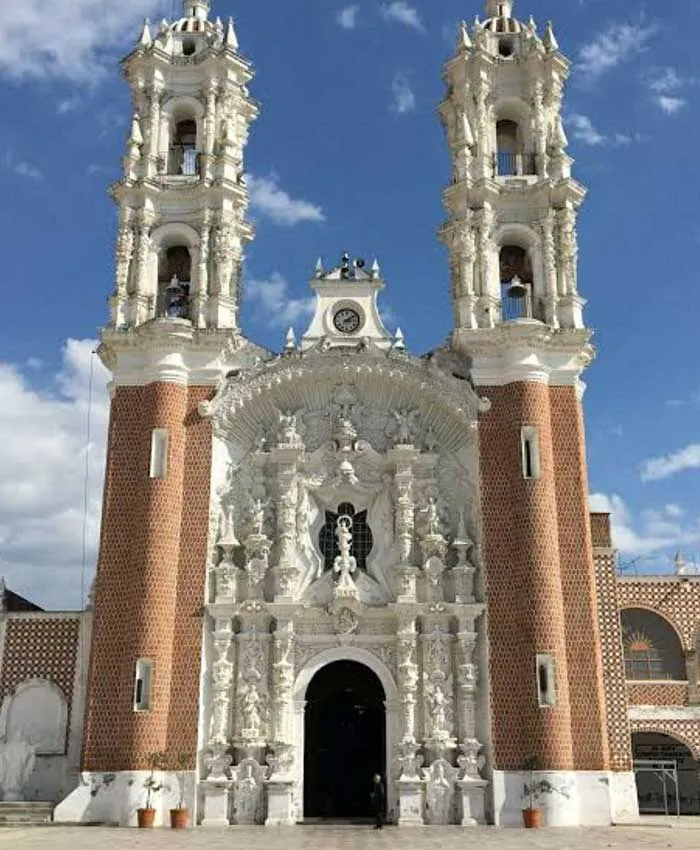
The twin towers are 33 m high and frame the great façade. Both towers culminate at the top with a small dome with a lantern, where two magnificent wrought iron crosses are respectively anchored. Its mixtili near plant bases, upholstered with hexagonal bricks with lime joints, its ornamentation occurs in both bell towers setting with a strong and warm color. The total number of columns in both towers is forty, plus 24 finials or finials, its construction dates from the last third of the 18th century. The theme of the towers is that of the Eucharist and for this reason the cylindrical columns are adorned with vines and grapes.
On the sides of the towers are the chapel of Guadalupe, which today is used as a baptistery, in which you can see four German stained glass windows and the Pilgrims’ Gate, with a tower-shaped viewpoint located at the opposite end of the tower. Guadalupe Chapel.
The Ship of the Temple
The main entrance is through a Neo-Baroque cedar gate, donated by Manuel Oscoy and a group of Tlaxcalans in 1946. The vault is made of lunettes, sectioned by transverse arches that are supported by pilasters, and a cornice runs over the limestone. The arches bear the names of Sara, Rebeca, Esther and Judith, strong women of the Old Testament and the Prototype of Mary.
The prism lamps were donated in 1952 by Carlos Paz Calderón. The benches are made of cedar corresponding to the year 1943 and the floor of the noble stone of Santo Tomás. The nave measures 36 by 11 meters. Previously, the temple had neoclassical altars paid for by the Marquise de Zabalza.
For the fourth centenary, the current decoration was made with golden plasterwork designs that give splendor to the place. In the place of the Altar, six niches were made that frame other canvases with themes alluding to the Apparition: To the north, they are works by Ignacio Dávila Tagle and to the south, by the painter Juan R. Fuentes, both of Puebla origin. The Stations of the Cross was made by Luis Toral from Zacapoaxtla Pue. The pulpit with its tornavoz was decorated with flowers between glasses.
Altarpiece of the Passion
It is located in the north arm of the transept, it is Churrigueresque in style and has gilded wood that extends to the arches and chroniclers. It commemorates the Passion and Death of Christ, common altar in the old churches. It consists of two bodies with four stipe columns in each one, plus a top with two columns that frame the window. In the central street there is a niche with a crucifix and in the center we see the Virgen de la Piedad with the dead Christ in her arms and the empty cross.
Loayzaga says that “Father Escobar (1670-1641) made the first altarpiece, in an ancient way but it is no longer the one we see today because its stipes and thick cornices correspond to the decade from 1770 to 1780 at the height of the Churrigueresque style”.
The Main Altarpiece
This extends under the dome and the main arches with the idea that when illuminated it resembles the ocote on fire. Up close it looks like a forest of columns and a garden of plants and flowers. In the background, in the central part, the Relic of the Virgin of Ocotlán is located in a glass niche.
The magnificent altarpiece is located in the apse and covers the walls in its entirety, forming a baroque golden grotto with a great unity of style. It consists of two bodies, a top and a small vault that crowns it. In its making, cedar wood and 23-carat gold were used. It consists of 28 stipe columns with a Corinthian capital. Two cornices with many breaks cross it. The niches have in common a rich base and a shell-shaped canopy.
The Ornament
It is formed by a garden of leaves, flowers and fruits. There are innumerable shells, chains of little flowers, garlands of pomegranates, undulating festoons, baskets with plant arrangements. In the Toral arch, five mirrors are engraved with the letters of the name of María.
The Iconography
The altarpiece reproduces the biblical page, full of color and content. With 17 full-length statues, 18 angels, 33 small statuettes. Little faces of cherubs angels children floating, young angels in polychrome garments in adoration, each one with carving of great artistic quality, in polychrome and stewed wood.
The Camarín de Ocotlán
At the back of the main altar is the Camarín, this is the place where they prepare the Image of the Virgin for religious festivals; on January 1 and the third Monday of each month of May to name the most important.
The dressing room is a perfect octagon full of color, devised by Loayzaga and made by the architect Francisco Miguel Tlayoltehuanitzin: a perfect pairing that he made from a mixture of sand and lime. The beginning of its decoration dates back to 1715 to conclude it in 1740, the date on which the Villalobos canvases were signed; decoration intact to this day with its primitive gold. It is a singular work of architecture and popular.
The Eight Columns
They are Solomonic and rise like flames and have a bulbous pedestal with three cherubs among pomegranates, acanthus and flowers. The capital is Corinthian with gold on a white background, there the trunk is perceived without knowing how so many branches are entangled without being confused, so many flowers. And the intercolumns serve as a framework for the works of the painters Juan de Villalobos and Luis Berruecos that they carried out in 1723 and 1725.
The eight angels are observed on the cornice and carry in their hands the insignia that express the conception of the Virgin. The eight mirrors shine at the feet of the angels. The eight letters of Ave Maria are repeated endlessly along the cornice. The seven canvases with luxurious leaf frames, a bow at the key and some giant scrolls at the base and are signed by the painter Juan de Villalobos in 1723, their measurements are 3.20 m by 2.35 m.
Eight monkeys can be found on the legs of the ahuehuete wooden table that is located in the center, as well as the richly carved furniture in the sacristy. The eight luboladas skylights open in the dome. The twelve Apostles and Mary representing the day of Pentecost are located at the top and in a circle of clouds and fire.
Ante Chamber
In the ante chamber there are five canvases by the artist Miguel Caro painted in the year 1781 that tell the story of the apparition of the Virgin. And we also find a San José by the painter Joaquín Magón.
Without a doubt, Ocotlán is one of the largest religious centers in Mexico and has been visited by millions of pilgrims since the 16th century. Every year hundreds of people arrive by bus from all parts of the country to venerate the Virgin of Ocotlán. It is also very common to see foreign tourists who come mainly from the United States, Japan and France, the latter visit it because of its similarity to another French church.
The Little Well of Holy and Healing Waters
“El pocito” is also well known. It is located about 400 meters from the Ocotlán Sanctuary, so it is easy to get there on foot. In that place people can go to drink water, which according to believers, has a healing power.
The first work that was carried out there was a retaining wall at the end of the 17th century, which later collapsed, as well as a square-plan chapel that was built between 1892 and 1896. There is currently a chapel whose construction dates from the first years of this century and that still preserves its old arch located at the entrance. In it are a canvas by Isauro G. Cervantes from 1913 and Murals developed by Desiderio Hernández Xochitiotzin and Pedro Avelino Conde narrate biblical episodes related to the water of the Place.
In the surroundings you can get the traditional red ducks where it is customary to bring water from the well.
Feast Day - 3rd Monday of May
As a tradition, year after year the great celebration of the Virgin of Ocotlán is held on the third Monday of May, with the procession of “La Bajada” of the Virgin to the city of Tlaxcala. The streets of the Tlaxcalan capital are decorated with flowers, paper, festoons, and long rugs of flowers and colored sawdust.
Church Visiting Time
Contact Info
Priv. del Nte., Ocotlán, 90100,
Tlaxcala de Xicohténcatl, Tlax., Mexico.
Phone No.
Tel : +52 246 462 1073
Accommodations
How to reach the Basilica
Puebla International Airport (PBC) in Puebla, Mexico is the nearby Airport to the Basilica.
Terminal Puebla Tren Turistico Train Station in Puebla, Mexico is the nearby Train Station to the Basilica.

